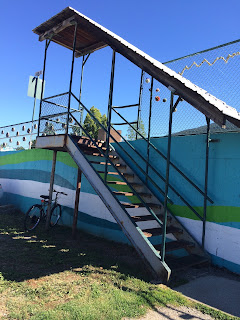

First stop was Kaslo, with its pretty false fronted main street and the world's oldest intact passenger sternwheeler. The S.S. Moyie logged almost a million miles carrying generations of miners, settlers, business and excursion crowds up and down Kootenay Lake. It's been meticulously restored and gives a good idea of the era before trains and cars.
Freight stored on the main deck: a fire fighting wagon and boxes of fruit for market.


The upper deck was for passengers with lounges, dining areas, plus cabins.
This is for passenger luggage and card playing.

Note the fire fighting buckets on deck and detailed gold leaf work inside.
Here's a look at the underneath part of the stern wheel. It was run by a huge steam engine on the main deck that burned coal.
Our next stop was New Denver located at the northerly end of Slocan Lake. New Denver is across the lake from Valhalla Park, which has some of the most amazing mountain peaks I've ever seen. This is an area for heli-skiing.
The road through this area is really lovely, often following rivers with banks fringed by blooming wild flowers.
New Denver is a sleepy little village now with a memorial to the Japanese Canadians who were sent here during the second world war. After the silver mining boom was over and the paddle wheelers stopped plying the lakes, many of these little towns were abandoned. Some of them burnt down but others remained as virtual ghost towns. These isolated places were chosen by the Canadian government as internment camps for the Japanese Canadians in the second world war. It was a shameful chapter in British Columbia's history. Thousands of citizens were rounded up and sent to camps and their property including farms, houses, vehicles, fishing boats, was confiscated with only token payment.
The memorial in New Denver has three of the original shacks plus a community hall and primitive bath house. It's an emotional place to visit and see the hardships that were forced on these families. Men were sent to separate camps and families were split up.
I found this home made sleigh very poignant, and also the makeshift kitchen and laundry area inside one of the shacks.
The grounds have now been planted as a beautiful Japanese garden, contrasting painfully with the squalor of the interiors of the buildings there.
Our final stop was the village of Nakusp, which I have heard of for years because a friend of mine was born there. It is located on the east side of Upper Arrow Lake in a stunningly beautiful area, a broad valley between two rivers surrounded by amazing mountains.

We spent the night in Nakusp and drove back to Nelson the following day. Some of the roads in this area are very twisty and high up and there was quite a lot of construction and repair going on so the trip took about twice as long as we expected. But it was a beautiful drive and I'm so glad to have seen this remote area of the province.
Today is our last day in Nelson and I promise to post about this unique city very soon.
















































